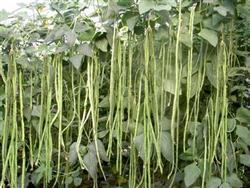Common diseases and insect pests of beans and their control
Beans are a vegetable that many people like to eat very much, but when we eat them, we should pay attention to check whether the beans are old, and don't eat the old beans. Because the old beans contain toxins, eating will make people vomit, dizziness poisoning, serious shock. Growing beans is relatively easy, but it still can not escape the harm of diseases, so what diseases will occur in the process of growing beans? How to prevent and cure it? Let's have a look!

1. Fusarium wilt
Disease characteristics: Fusarium wilt mainly harms the roots and leaves of beans, the disease will begin in the lower part of the plant at the initial stage of infection, water-stained patches will appear on the leaf edge, and the plaques will gradually expand and extend, until finally the whole leaves unite to form the whole plaque, and finally the leaves die. And cracks will begin to appear in the rhizome, the color will gradually become darker, the external humidity is too high and mildew spots will appear on the plaques.
Control methods: continuous cropping can not be carried out on the same piece of land, at least two-year rotation should be guaranteed, and the crop rotation should not be legume crops. Improve the soil, neutralize the acidity of the soil and reduce the pathogen. After the onset of the disease, carbendazim wettable powder and other drugs can be used for prevention and treatment, the dosage depends on the incidence of the disease, at least once a week, lasting for one month.
2. Virus disease
Disease characteristics: virus disease mainly harms the leaves of beans, leaves infected with the disease will appear in the part of the leaf color deepening, the sick place will appear uneven phenomenon, and then begin to bend. Virus disease will delay the time of flowering, the time of flowering is uneven, the rate of pollination and fertilization is seriously reduced, which has a great impact on yield and may even lead to sterilization.
Control methods: when selecting varieties, we should choose disease-free and harmless varieties with strong disease resistance, observe more in the planting process, strengthen the use of chemical control, and improve the resistance of beans. As the main transmission is aphids, aphids not only spread viral diseases, but also have a great impact on crops, so we should also pay attention to the prevention and control of aphids. Reduce the transmission of pathogens and reduce the incidence.
3. Bean rust
Disease characteristics: bean rust is mainly harmful to the leaves, when the leaves infected with bean rust will appear colored patches on the leaves, with the passage of time, the color will gradually deepen, the affected part will also begin to protrude. The protruding place is the pathogen spore, and the red powder will appear after the seed coat surface is broken.
Prevention and control methods: after harvesting the first crop of beans, carry out comprehensive disinfection in the orchard, destroy the diseased body, stay away from the vegetable garden and avoid re-transmission. Select the varieties with strong disease resistance and carry on the pesticide prevention to the plant appropriately.
The above are the diseases that often occur when planting beans, and the most important thing to pay attention to is the prevention and control of diseases, and the harm of the disease is very great. If it is light, it will lead to a reduction in production, while if it is heavy, it will lead to no production of beans, so we must do a good job in prevention and strengthen the management of the garden, so that our hard work will not be wasted. This is the end of the introduction of this article, please continue to follow the editor!
- Prev

Cultivation techniques of beans in early spring in plastic greenhouse
Symptoms of bean blight: mainly harmful to stems, leaves and pods. At the beginning of the disease, the stem showed a water stain, and then the wet rot constricted around the stem, and the leaves and vines above the diseased part withered. When the humidity was high, the cortex rotted and the surface produced white mold. The infected part of the leaves showed dark green water stains at first, then enlarged into round light brown spots and white mold on the surface.
- Next

Planting methods of pakchoi
Planting methods of pakchoi
Related
- Where is it suitable to grow horseradish in China? it is expected to see the middle altitude horseradish in Alishan.
- How to prevent tomato virus disease reasonably? (Control methods included)
- Many people like to plant towel gourd on the balcony. What are the main points of this method and management?
- What crops can chili peppers be mixed with?
- Fertilization techniques and matters needing attention in Tomato
- What are the grafting techniques for peach seedlings in spring?
- Harm and control methods of root swelling disease of Chinese cabbage
- What are the pests of sweet potatoes? How to prevent and cure it?
- Symptoms, causes and Control methods of navel Rot in Tomato
- The cause of "Cucumber rotten bibcock" in Farmers' planting Cucumber and its Control Plan

